An original historic floor contributes enormously to the character and the spirit of a place. Whether it’s humble cobbles or stately marble hall, the floor tells the story of the building. When people enter an old building, step onto a churchyard path or walk down a street in an ancient town or village their natural inclination is to look up – at the ceiling, at the windows, at the walls, at the buildings above and around. That’s why the SPAB have launched the History at Your Feet Campaign. Tweet @SPAB1877 with your favourite historic floors. We hope this round up of the SPAB’s favourite floors will inspire you to #lookdown.
The Chapter House steps at Wells Cathedral, Somerset
Also known as the ‘sea of steps’, (the self-explanatory name taken from an evocative 1903 photograph by Frederick H. Evans), the famous and beautifully worn stone Chapter House steps of Wells Cathedral were built from 1286 and the upper flight in 1459-1460.
The staircase itself divides at the top with one branch leading through to Chain Gate (which in turn leads to Vicars Hall and Vicars’ Close) and the other branch leading to the Chapter House. Now, worn away by centuries of use, the wear and tear of tramping feet can be seen on the staircase. Image credit: Wells Cathedral.
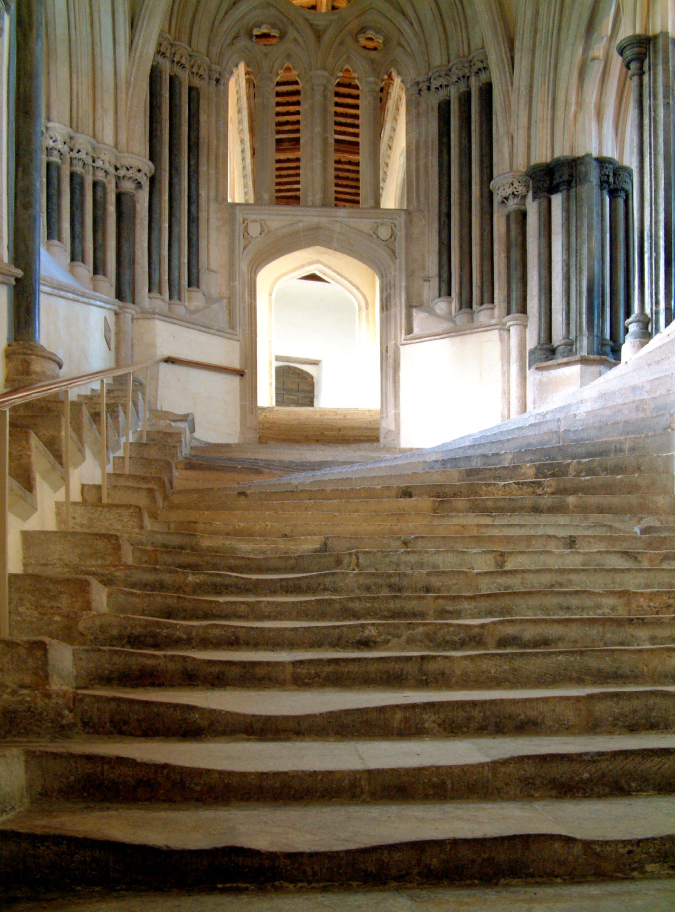
Image credit: Wells Cathedral
Cosmati Pavement at Westminster Abbey
The great pavement in front of the High Altar of Westminster Abbey is remarkable. It was laid down in 1268 by order of Henry III who had started re-building Edward the Confessor’s Abbey in the new Gothic style in 1245. The workmen came from Rome. The pavement belongs to a type of inlaid stone decoration known as Cosmati work, after one of the families of craftsmen who specialized in it. The technique is called opus sectile, ‘cut work’. The great pavement is 24 feet 10 inches square and consists of geometrical patterns built up from pieces of stone of different colours and sizes cut into a variety of shapes: triangles, squares, circles, rectangles and many others. The central roundel is made of onyx and the pavement also includes purple porphyry, green serpentine and yellow limestone. Pieces of opaque coloured glass were also used. It lies on a bed of dark limestone known as Purbeck marble. Its uniqueness and completeness combine to make the pavement one of the pre-eminent works of art of medieval England. Its importance cannot be overstated.
Very few churches in medieval England are known to have possessed Cosmatesque floors. Fragments from destroyed pavements have been found at St Augustine’s Abbey Canterbury and Old Sarum, Salisbury. There is a surviving floor fragment in the Trinity Chapel at Canterbury Cathedral (restored and re-laid), and historical evidence for one at old St Paul’s Cathedral.
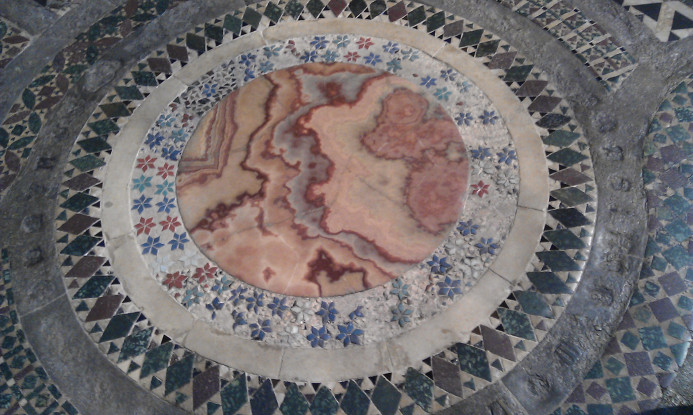
Image credit: SPAB
Old Royal Naval Chapel floor
The Chapel of St Peter and St Paul at the Old Royal Naval College is a neo-classical masterpiece by James ‘Athenian’ Stuart and William Newton. It is one of the finest eighteenth century interiors in the UK. Naval motifs are depicted throughout the Chapel, reflecting the building’s original purpose as a place of worship for the inhabitants of the Royal Hospital for Seamen. This is a great place to #lookdown. In the centre of the black and white marble floor there is a ship’s anchor, and a rope design runs along the edge of the pews which is said to match exactly the diameter of an anchor cable of a ‘first-rate’ ship of the line.
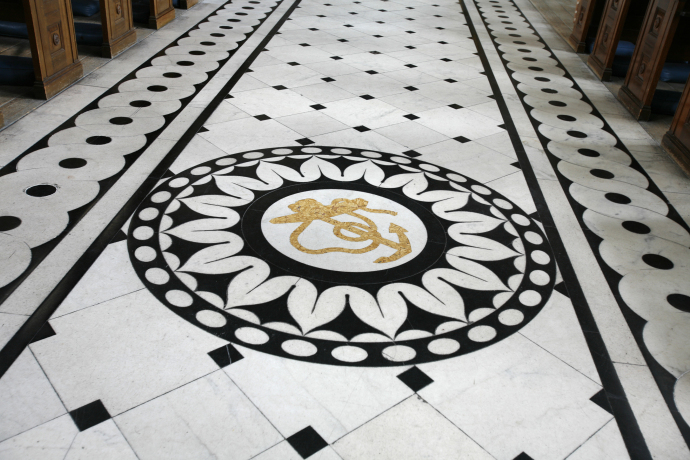
Image credit: Old Royal Naval College
The wooden floor of the long gallery at Chastleton House, near Moreton in Marsh, Oxfordshire
In grand Elizabethan and Jacobean houses the long gallery was primarily a place to exercise in bad weather. It was also where a family on the rise might display a collection of art and ancestral portraits. Chastleton House in the Cotswolds, owned by the National Trust, was built by a rich wool merchant (or possibly lawyer). Nikolaus Pevsner described the decoration of Chastleton as “blatantly nouveau riche, even barbaric, uninhibited by any consideration of insipid good taste”, but now the long gallery has mellowed to a charming space of uneven boards and gentle patination. Rowan Moore says of it: “What is particularly pleasurable is the way the stuff of the ceiling – ornamental plaster – descends, while the stuff of the floor – wood – rises in the form of panelling and the two meet at mid-height. It gives a boat-like sense of enclosure and protection.”
Dan Cruickshank says: “If the floor is right an historic room doesn’t need much else to make it work. The gnarled, wide, oak boards in the Long Gallery at Chastleton House are pretty good I think.”
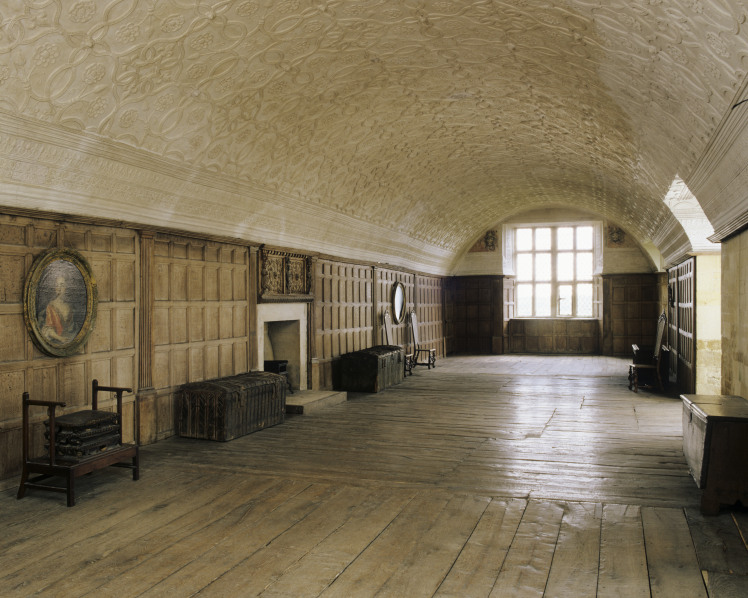
Image credit: National Trust images/Nadia Mackenzie
The sloping wooden floor of St Mary’s Guildhall, Coventry
This ‘queasy’ floor was suggested by broadcaster and architectural historian, Jonathan Foyle, who says: “Upstairs in St Mary’s Guildhall in Coventry is a humble boarded floor that can’t be how its makers intended it six hundred years ago. The timber-framed building has warped so much that there’s no chance of playing marbles in there ever again. Toboggan, maybe. But that sloping room has gained the wonderful quality of having quietly witnessed the passage of time.”
Marcus Lynch General Manager of St Mary’s Guildhall adds: “Some visitors emerge feeling rather disorientated, and even queasy as to some the room resembles the cabin of a (sinking) galleon. The original function is not recorded, but it is most likely to have been an ancillary meeting chamber for the conduct of council or merchant guild business.”
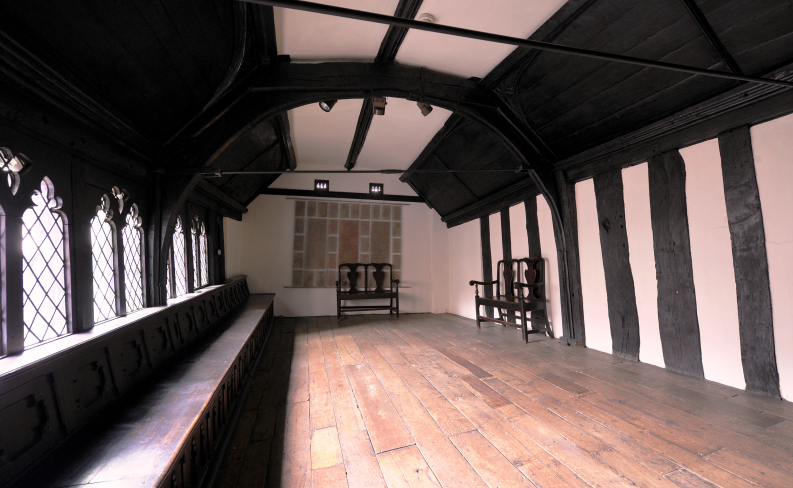
Image credit: St Mary’s Guildhall
The brick paviour floor of St Agnes’ Church, Cawston, Norfolk
SPAB’s head of Casework, Emma Lawrence says: “On a recent site visit to St Agnes’ Cawston (Norfolk) I was bowled over by this floor. The pew benches are medieval in date and the beautiful, simple unglazed bricks underneath may perhaps date from their installation. They are a great example of the way an apparently ordinary floor can contribute enormously to a sense of place.”
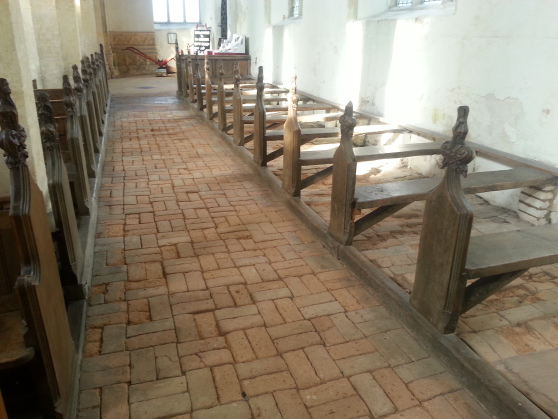
Image credit: SPAB
The tiled floors of the Victoria and Albert Museum created by female convicts at Woking Prison
These were suggested by Olivia Horsfall Turner, Curator, Designs, Victoria and Albert Museum. She says: “’My favourite V&A floors have to be the ‘opus criminale’ mosaic floors. The most spectacular example is located in the corridor between the cast courts, and we have the original design for it in the Designs collection as well. These mosaic floors were created by women convicts in Woking Prison, under the supervision of designers attached to the V&A. The Museum had a strong notion of its social role and the intention was that by making the mosaics, the prisoners would be morally improved. The designs were produced and sent to the prisoners, who made up tiles accordingly – the tiles were then sent back to the Museum and installed. Some of the mosaics were complex, others were simple geometric patterns in black and white. They are found in various places throughout the Museum, including just outside my office. Every time I walk over them I think about the women of Woking prison who made them – unnamed and unknown but who contributed to one of the most distinctive features of the V&A’s interior decoration.”
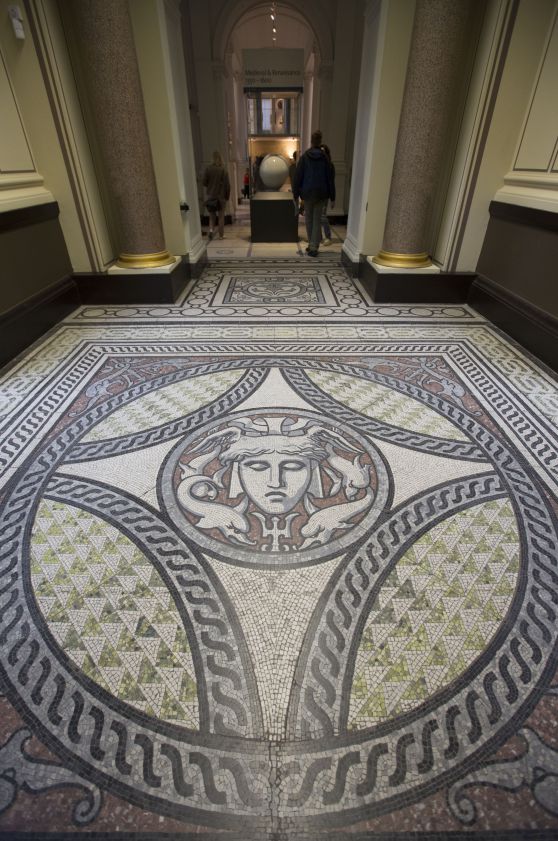
Image credit: V&A Museum
The tomb-lined floor of St Mary’s Church (the Ramblers’ Church), Lead, North Yorkshire
This tiny rectangular building is very simple. It was probably built by the Tyas family, which numbered crusading knights whose massive 13th century grave slabs are set into the floor. Carved with heraldic symbols and inscriptions, they are an evocative and important collection, adding immeasurably to the church’s distinct atmosphere.
Since being rescued by a group of walkers in 1931, St Mary’s has been known as the Ramblers’ Church. Nearby is Towton, the site of the battle believed to be bloodiest in English history, which brought the Wars of the Roses to an end in 1461.Ten thousand men are said to have been killed and Cock Beck, the little stream which visitors have to cross to reach St Mary’s, is said to have run red with blood.
Despite its history, St Mary’s is a peaceful place. Today it is cared for by the Churches Conservation Trust.
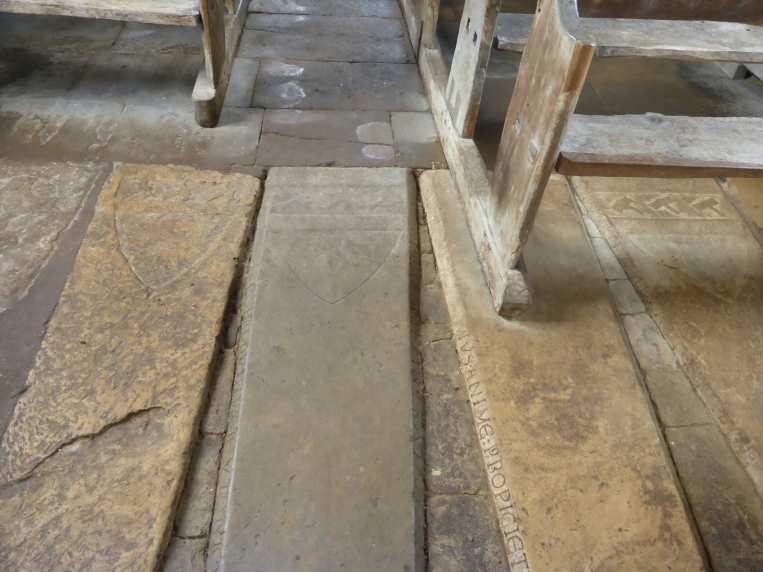
Image credit: Churches Conservation Trust
The encaustic tiled floor of the retrochoir, Winchester Cathedral
SPAB supporter Kevin McCloud says: “I’m a big fan of looking down as well as up at buildings. My favourite international floor has to be the heroic mosaic floor of Otranto Cathedral (the departure place of worship for crusaders) that depicts Alexander, Noah, Adam and King Arthur, among a host of characters. In Britain, the retrochoir in Winchester Cathedral is a riot of encaustic tiles that is a destination in itself. I also photograph old manhole covers and street furniture; an odd hobby I know, that probably takes an interest in what lies beneath a little too far!”
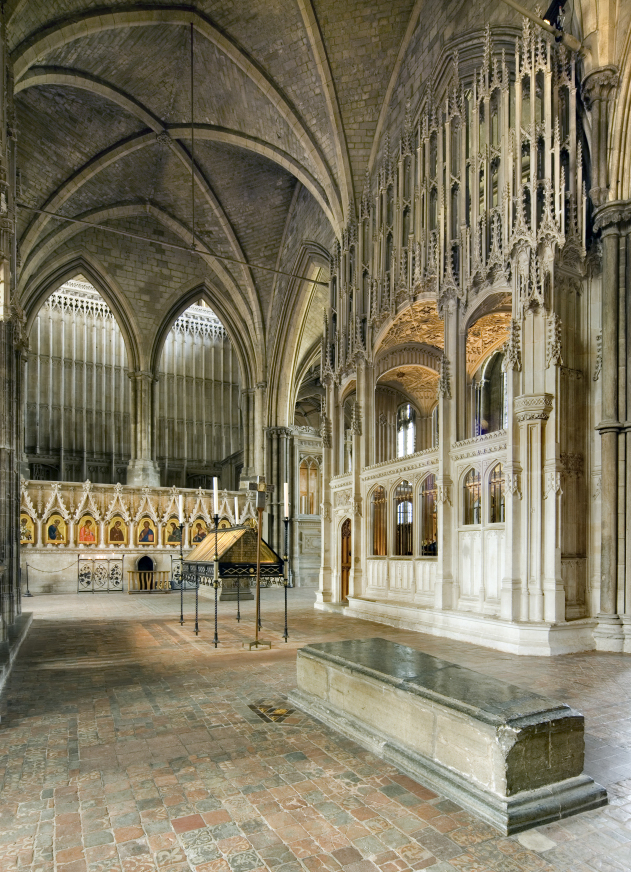
Image credit: Dr John Cook
The painted wood floor of the Tyrconnel Room, Belton House, Lincolnshire
Old painted floors are relatively unusual. Their very nature makes them liable to wear and tear. They are said to have been more common in Scotland, and several instances are recorded in Edinburgh’s New Town. They would have been cheaper than marquetry, an alternative for such decoration.
One of the best surviving examples in England is located in the Tyroconnel Room at Belton House in Lincolnshire. Its heraldic design and use of only three colours is unusual. Incorporating the symbolic Belton greyhounds and the arms of the Brownlow family (former owners of the house) the floor is the subject of continuing controversy. Some believe it to date to the 17th century, others hold that the design places it in the 18th century. Present owners, The National Trust, does not believe it could have stayed intact for so long if it were the former. Since there is some evidence to support both claims, the longevity of Belton’s painted floor remains an enigma.
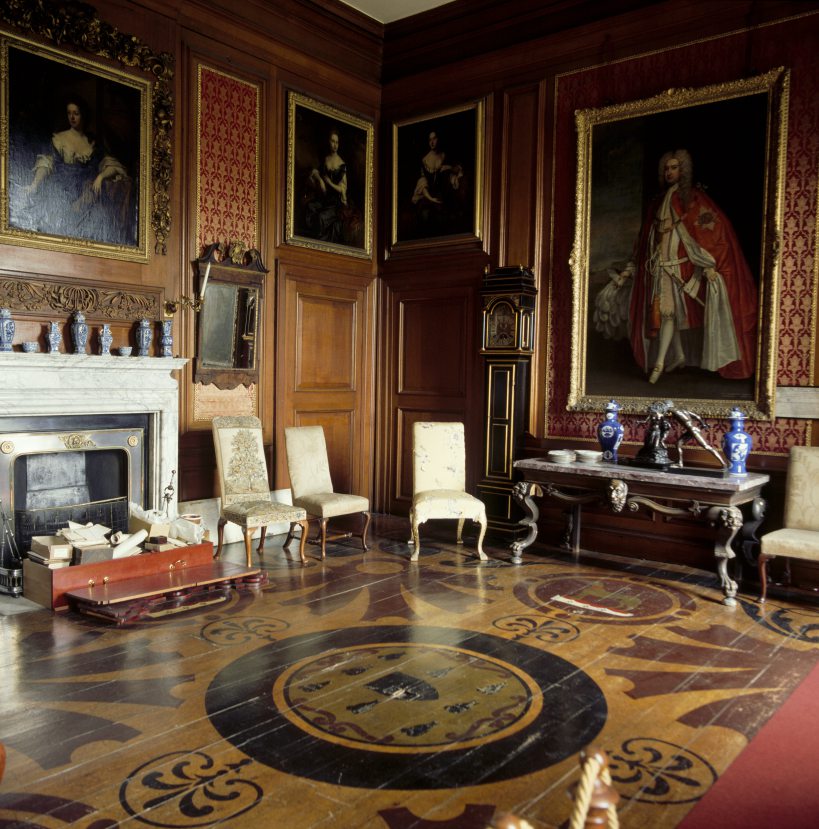
Image credit: National Trust Images/Graham Challifour
The 19th century encaustic floor tiles at the medieval church of St Jerome at Llangwm Uchaf in Monmouthshire, Wales
This strikingly colourful tiled floor of this Grade-1 medieval church is a Victorian work of art. The figure tiles were made by William Godwin of Lugwardine, one of the leading encaustic tile manufacturers of the 19th century, and the patterned tiles were made by the equally famous Maw and Co. John Newman in the Pevsner for the county refers to the “nave and chancel tiled throughout in a handsome and coherent pattern, also designed by Seddon” (J.P.Seddon, architect for the substantial rebuilding of the church in 1863-9) and deems them “deserving of close examination.” St Jerome is the newest vesting with charity The Friends of Friendless Churches.
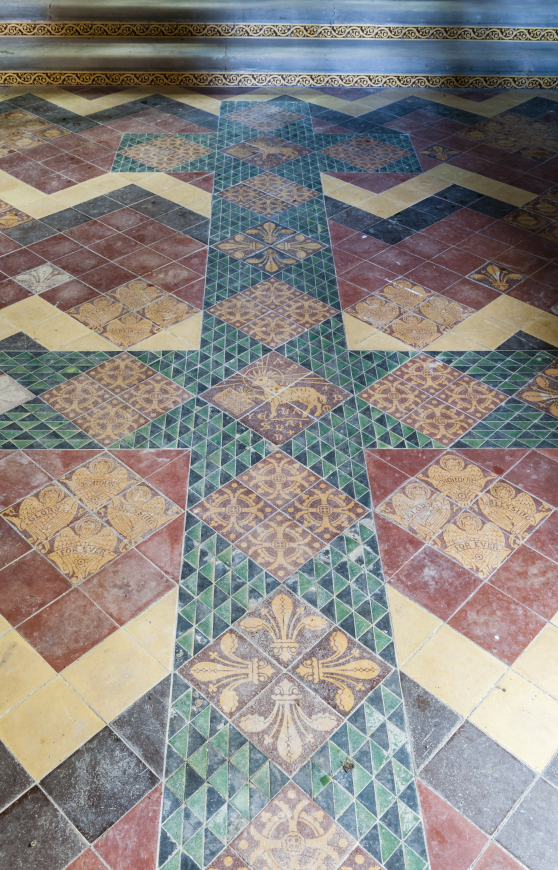
Image credit: Friends of Friendless Churches
The medieval decorated tiles at Strata Florida Abbey, near Aberystwyth, Wales
Dating from the 12th century, the remains of the huge carved Romanesque west doorway give visitors a clue to how impressive this building must once have been. The plan of the church can still be clearly traced and, remarkably, some of its original richly decorated tiles are still intact. Two of the most well known tiles are ‘Man with the Mirror’ said to warn of vanity and a heraldic griffin.
Known as the Westminster Abbey of Wales, Strata Florida Abbey was once a site of huge religious significance. Dafydd ap Gwilym, one of the best known of Wales’s medieval poets, is buried there under a yew tree and it is said to be the burial place of several Welsh princes. There are also intriguing links to the legend of the Holy Grail. Image credit: Kate Griffin.
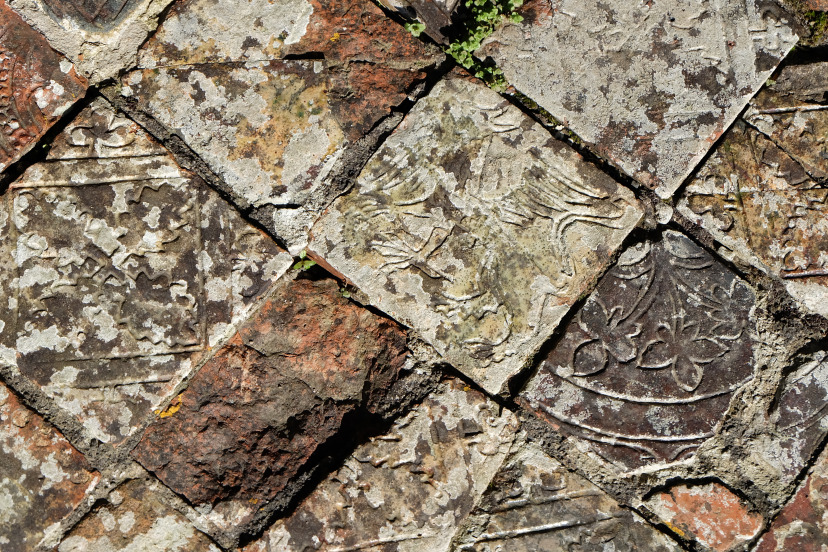
Image credit: SPAB
The flagstone floor of the kitchen at Canons Ashby House near Daventry, Northamptonshire
The beautifully worn flagstones of the kitchen at Canons Ashby House in Northamptonshire tell a story. They are a testament to the work (and feet!) of generations of servants. Today these mellow stones have a wonderfully smooth patchwork patina
Built by the Drydens using the remains of a medieval priory, the house and gardens have survived largely unaltered since 1710 and are today cared for by the National Trust.
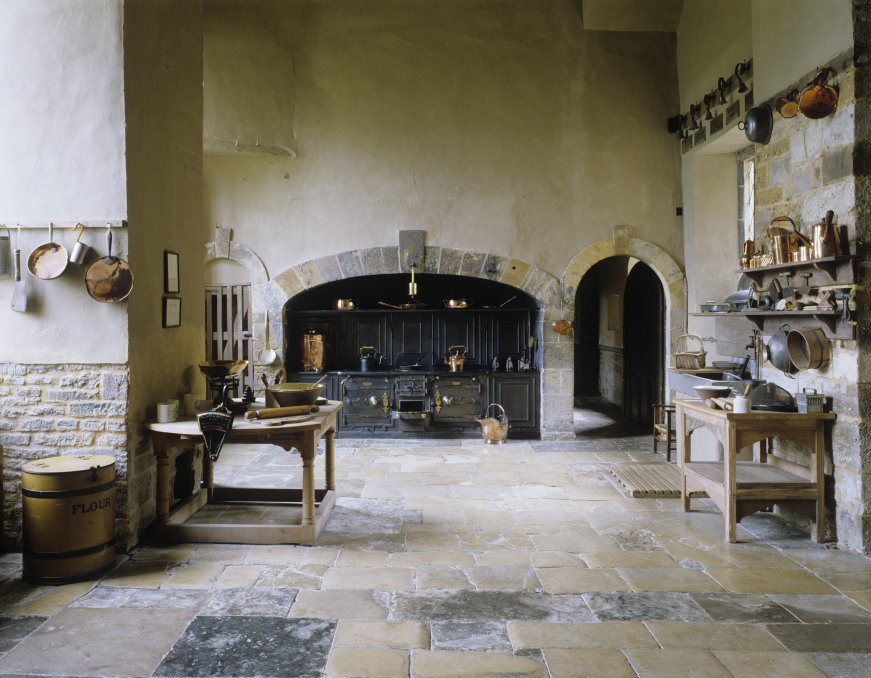
Image credit: National Trust Image / Andreas von Einsiedel
The painted floor (underside!) of Gladstone’s Land, 477b Lawnmarket, Edinburgh
This picture shows the underside of a floor, so it is quite permissible to look up as well as down. In the 17th century voids were not built between ceiling and floors, so that in effect the ceiling was simply the floorboards of the rooms above – therefore this original and spectacularly painted ceiling at Gladstone’s Land, Edinburgh is actually spectacularly painted floorboards. The house of wealthy merchant and landlord Thomas Gledstanes showcases high-rise living, 17th-century style, at the heart of Edinburgh’s historic Royal Mile. Gladstones Land is owned by the National Trust for Scotland.
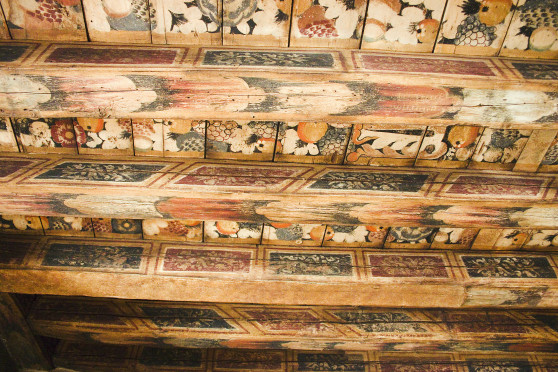
Image credit: National Trust for Scotland
The medieval tiles of All Saints’ Church, Icklingham, Suffolk
Loyd Grossman, outgoing chairman of the Churches Conservation Trust says: “My favourite floor is to be found in All Saints’ church, Icklingham, Suffolk, which is looked after by the Churches Conservation Trust. All Saints’ is a mediaeval church and areas of the chancel and sanctuary floors contain a large and very rare collection of early-14th century encaustic tiles. Although now worn, you can see they form patterns with a variety of designs, including cinquefoils in circles, foliage, lions’ faces, pairs of little birds and a few human faces.”
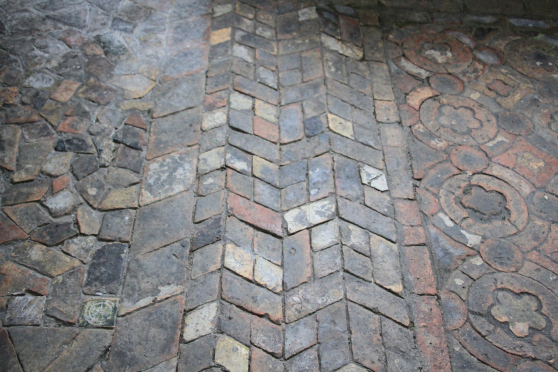
Image credit: Peter Emina
The mosaic floors at Bignor Roman Villa, West Sussex
The Roman mosaic of Venus and the Gladiators is one of several magnificent floors at Bignor Roman villa in West Sussex.
Roman buildings include floors of many types, but perhaps most strongly associated with the period are the mosaics formed from small tesserae. These high status floors survive in reasonable numbers in this country and combine function with craftsmanship and great artistic skill. Many mosaics lay buried for centuries and the drama of rediscovery is illustrated by the case of Bignor Villa, West Sussex. Bignor was one of the earliest antiquarian finds when unearthed in the early 19th century and, in their book on the villa, David Rudling and Miles Russell, describe the amazing moment when the mosaic floor was first seen by farmer George Tupper after centuries in the soil. This was not merely the exposure of a floor but the opening of a window onto another world:
“Grubbing around on his hands and knees, Tupper soon found himself staring down in amazement at the tessellated face of a young man. Subsequent energetic spoil clearance revealed the larger mosaic depicting the figure of the man, naked except for a bright red cap and fur-trimmed boots, an immense eagle and, further afield, a series of scantily clad dancing girls’. Roman mosaics like that at Bignor represent the floor at its most artistic and extravagant.
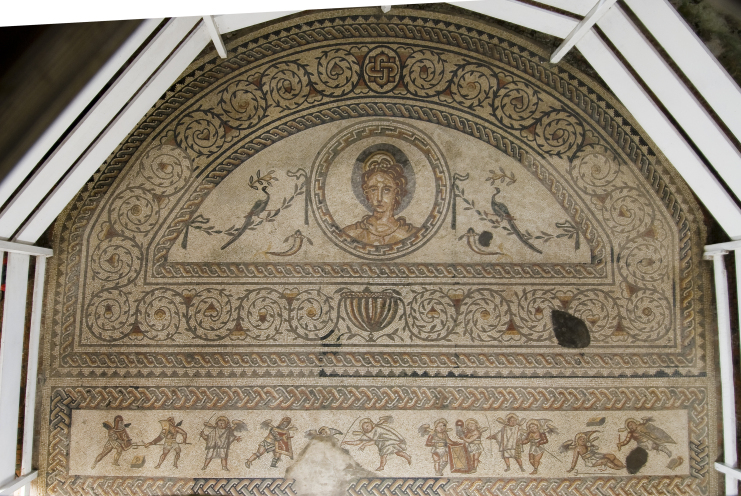
Image credit: Lisa Tupper
The tiled floor of the Dabbling Duck, Great Massingham, Norfolk
This simple and beautifully worn floor represents the thousands of old pubs throughout the country where centuries of custom and farm workers’ boots have left an indelible impression. With so many ancient pubs in towns and rural communities facing an uncertain future it’s important to acknowledge their place in the historic built landscape. The beamy, atmospheric Dabbling Duck overlooking the pond in one of North Norfolk’s most picturesque villages was threatened with closure until it was reopened in 2006. This was the result of a tireless community action group and a far-sighted local authority’s 6 year campaign to prevent the beautiful old building (previously the Rose and Crown pub) from being converted into housing.
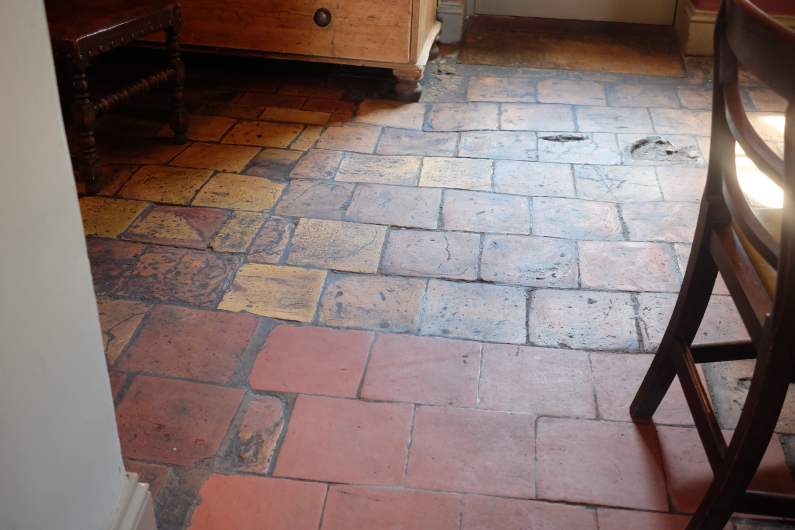
Image credit: SPAB
The bridge at Barton Farm, Bradford on Avon, Wiltshire
SPAB Director Matthew Slocombe nominates an unlikely exterior floor. He explains: “For some years my daily walk to school took me over the medieval bridge at Barton Farm in Bradford on Avon, Wilts. The bridge is a wonderful ancient structure which formed part of a packhorse route over the river Avon and up the steep hillside nearby. Part of the bridge was paved with beautiful, undulating stone setts, but other parts were nastily tarmaced. This was remedied when SPAB Craft Fellow Andrew Ziminski and his firm replaced the tarmac with a lime concrete – a bold and experimental move at the time. The floor has performed extremely well, providing an attractive, durable and sympathetic surface,which is also safe and comfortable for pedestrians to use.
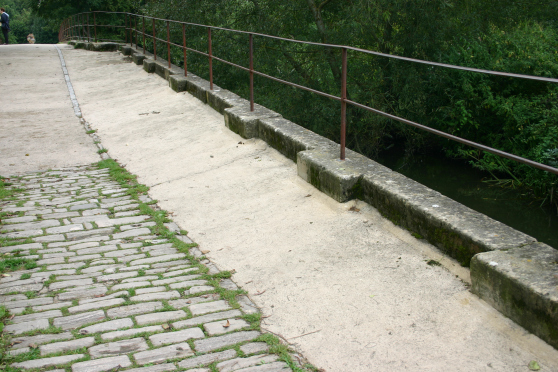
Image credit: SPAB
The boarded wooden floor of explorer David Livingstone’s tenement birthplace at Shuttle Row, East Kilbride, Scotland
Shuttle Row is the birthplace of the most famous of Victorian explorers, David Livingstone. Livingstone’s early life was quite typical of the time. He was born in 1813 in a one-room flat in Shuttle Row, a tenement shared with 23 other families.His parents both worked at the nearby Blantyre Cotton Mill where, aged 10, David also started working 14 hours a day to bring in money. From these humble beginnings as a factory boy to becoming the first European to explore large areas of Africa was a long, hard journey. When he wasn’t working at the mill, he educated himself until he was accepted at Anderson’s College in Glasgow to study medicine and theology, where he studied for hours after a full day’s work. This allowed him to become a missionary doctor and he made his first trip to Africa in 1841.
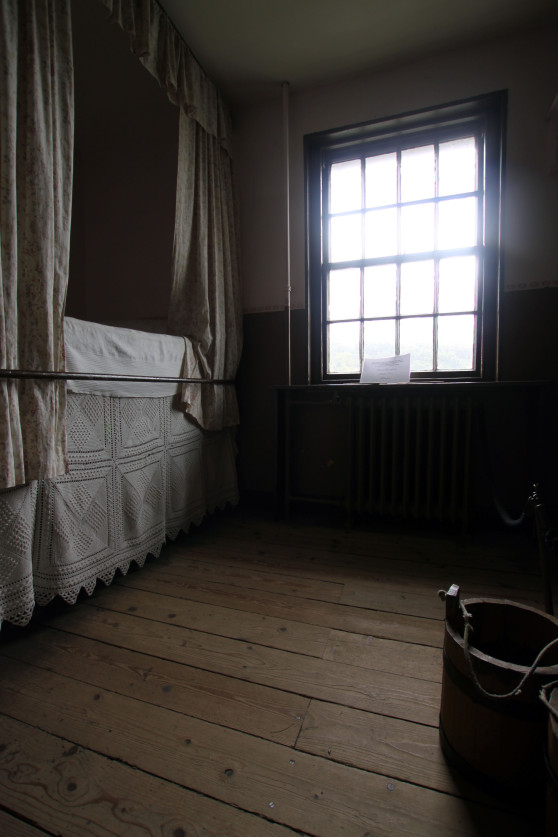
Image credit: Historic Scotland
The black and white marble Central Hall at the National Trust’s Seaton Delaval, Hall Northumberland
Chosen by Dame Helen Ghosh, Director General of the National Trust, who says: “This wonderful marble floor has taken all sorts of punishment – fire and flood, falling statues and falling 18th century party guests – and it survived!”
Built for the extraordinary Delaval family, Seaton Delaval was one of architect Sir John Vanbrugh’s smallest country houses. The house and surrounding landscape were in-keeping with restrained classical Georgian style, but behind the formality lies a story of theatrical excess.
Known as the ‘Gay Delavals’, in an age notorious for extremes of behaviour the family stood apart as the most notorious of all Georgian partygoers and pranksters. The Delavals loved a performance, staging events from rope dancers and sack races outdoors to masquerade balls and even their own theatrical productions. A devastating fire in 1822 left the Central Hall at Seaton Delaval Hall roofless and open to the elements for 40 years. Unfortunately the black and white tiled floor – the scene of many wild parties – fell victim and became damaged. The slabs were unstable and loose, so much so that every time they were walked on there was risk of them moving against each other and chipping the edges.
The central hall is now something of a phoenix. Stone masons carefully numbered, plotted the position of and lifted every slab from the floor. Once lifted, all the numerous cracked and shattered slabs were painstakingly bonded together again using resin adhesives mixed with pigment, and stainless steel dowels have been added to give them strength. The original three layers of screed have been replaced where they had been weathered to nothing, and now, where possible, each slab has been returned to its original position.
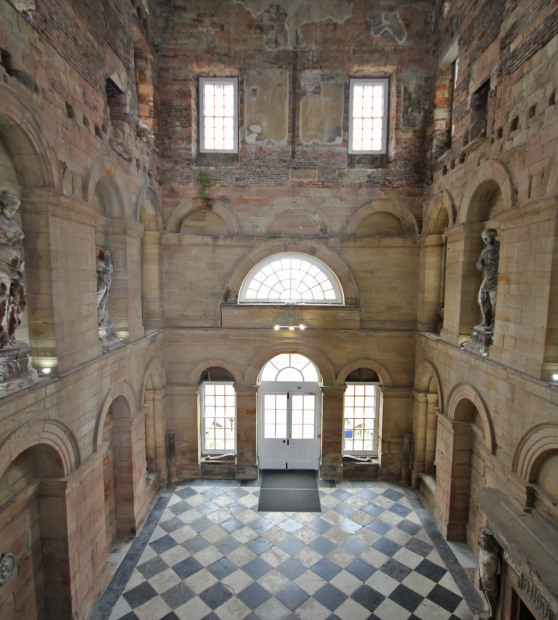
Image credit: National Trust Images-Dennis Gilbert
